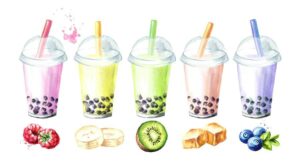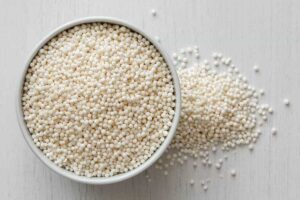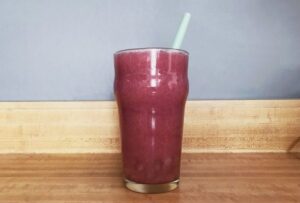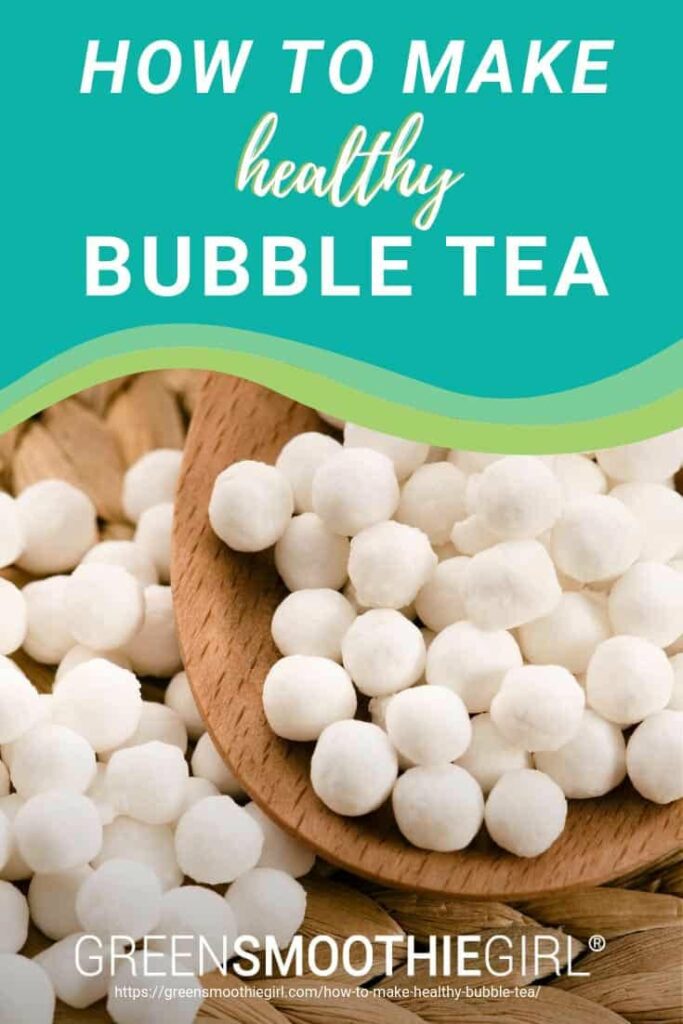How To Make Healthy Bubble Tea (Is It Possible?)

Have you ever seen someone sipping something sweet-looking with a bunch of little black pearls swirling around the bottom of their plastic cup? That’s boba tea, also known as bubble tea.
The drink originated in Taiwan and has since spread internationally, offering a cold and tasty treat on a hot summer day. Brown, pink, green, yellow—it comes in many colors and flavors with a wide straw to suck up all the boba pearls.
But what makes up the drink with the jelly-like “bubbles,” and is it any good for you? And can you make bubble tea more healthy at home?
In this post:
What is Bubble Tea?
Bubble tea (also known as pearl milk tea) starts out as sweetened tea (typically black, green, or oolong). At tea shops, you’ll see fruity flavors on the menu, like strawberry or passion fruit, but those are optional.
Many varieties of bubble tea have milk added to them, and the type will depend on the shop you visit, but it can range from powdered, condensed, or fresh milk, to non-dairy options like almond milk or oat milk.
The boba are often made with tapioca, which is a starch extracted from cassava root. They're usually black and get their color from the brown sugar that is often mixed in. They have a chewy, jelly-like texture and are sometimes available in different flavors.
After choosing your flavors and additional sweeteners (if you want them), the person making your drink will shake it up like a cocktail and pour it into your cup. Most tea shops will seal your cup with a spill-proof cellophane top, rather than the plastic to-go lids that we’re used to from coffee shops. You’ll simply pierce the seal with a big straw and start sipping!
How Bubble Tea Got Its Name
Even though “bubble” sounds like a cute way of saying “boba,” bubble tea doesn’t get its name from mispronunciation. The bubbles actually refer to the air pockets that result from all that shaking and mixing. But so many people use the two words interchangeably, the boba may as well be “bubbles”!

Is Bubble Tea Healthy?
While bubble tea is certainly tasty, it’s not anything you’ll be drinking for your health. Here’s why:
- Most recipes use dairy milk.
As I mentioned, the milk can be fresh, powdered, or condensed. I’ve written at length about all the reasons we should skip out on dairy milk. As a refresher, cow’s milk is inflammatory to your tissues, highly allergenic, and it’s likely from cows treated with steroids and hormones. Condensed milk is worse, often heavily sweetened with refined sugar.
- Bubble tea is flavored with syrups and mystery powders.
Adding flavor to the already sweetened drink can bring even more sugar to the mix. While some shops use fruit pulp to flavor their bubble teas, many use powders or syrups that are filled with sugar too, along with preservatives, artificial food coloring, and other ingredients we don’t want in our bodies.
[Related: How To Avoid Hidden Added Sugar In Your Food]
- The boba have no nutritional value.
If the boba were made entirely of tapioca (a whole food), they wouldn’t be so bad; after all, tapioca’s resistant starch (also known as prebiotics) help feed the good bacteria in your gut.
But in boba, tapioca is typically used in combination with other flours or used in small amounts as a thickener. These boba have little nutritional value, and even if there is a good amount of tapioca in them, all the sugar in bubble tea negates any potential benefit.
- Bubble tea may contain dangerous additives
In an effort to reduce costs, many manufacturers of boba tea mixes used DEHP, or bis(2-ethylhexyl)phthalate, a chemical that is typically used to soften plastic. It has been found in some flavoring syrups, too.
DEHP is a potential carcinogen and studies have shown it to affect hormones and fertility3.
Other allergenic and potentially dangerous additives have been detected in some boba tea products, such as “styrene, acetophenone, and brominated substances that shouldn't be in food at all,” according to Manfred Möller of the Institute of Hygiene and Environmental Medicine at the University Hospital Aachen (UKA), which tested the samples4.
[Related: Can You Spot Neurotoxins On Your Food Labels?]
How to Make Healthy Bubble Tea
Making healthy bubble tea on your own will start with making the tapioca pearls from scratch. While you can purchase dehydrated tapioca pearls to reconstitute, the best version of bubble tea is the one you make at home.

You get to control the ingredients, which means you can avoid artificial colors, chemicals, or additives. The main ingredient is tapioca starch, also known as tapioca flour, which you can find in the flour area of the grocery store.
This recipe will make 2-3 servings.
Healthy Bubble Tea Recipe
Ingredients
For the tapioca pearls:
- ½ cup tapioca starch
- 3-4 tsp boiling water
For the tea:
- 3 bags of organic black, green, or oolong tea of your choice
- 6 cups boiled water
- 3 tbsp honey or real maple syrup (optional)
- ½ cup dairy-free milk (almond milk, coconut milk, or oat milk, for example)
Directions:
1. Prepare the tea as directed on the package. Typically, you steep black tea for 3-5 minutes, green tea for 1-3 minutes, and oolong tea for 1-5 minutes. The longer you steep, the richer the flavor. Stir in honey or maple syrup, if using. Let it cool.
2. While the tea is cooling, mix the tapioca starch and boiling water in a bowl with a fork. It is key for the water to be at boiling point so it cooks the tapioca and gives it an elastic texture. Once the hot water is incorporated, you can use your hands to knead the mixture into a dough (don’t burn yourself—be careful and use common sense if it needs to cool down more). Cut pieces of the dough and roll them out into small ropes, which you can then cut into small pieces that you will roll into little balls. If you’ve ever made gnocchi, this is the same way to do it.

3. Cook the tapioca pearls by adding them to boiling water (make sure there’s enough to cover them) and have an ice bath ready for them when they’re finished. Boil for about five minutes. Remove with a slotted spoon and place into the ice bath.

4. Stir in your sweetener, if using, and milk of choice once the tea has cooled. Divide tapioca pearls into cups and add the tea mixture. Enjoy!

How to Add Flavor to Bubble Tea
- If you’d like to flavor your bubble tea, you can blend in pureed whole fruit. Simply add the milk tea mixture to a blender with ¼ cup fruit and pour the result over the tapioca pearls. You can also try using organic, pure extracts like vanilla or coconut.
[Related: Why You Shouldn’t Be Afraid Of Sugar In Fruit And Other Whole Foods]
How to Add Protein, Fat, and Fiber to Bubble Tea
- Feel free to add chia seeds to your bubble tea (either on their own, or in addition to the boba—experiment and see what you like!). It’s not the authentic Taiwanese way, but they have a similar gelatinous texture when they’re added to liquid and begin to absorb it.
Two tablespoons (about one ounce) of chia seeds contain 4 grams of protein and a whopping 11 grams of fiber. It also contains 9 grams of healthy fats, more than half of which is omega-3 essential fatty acid4. Make sure you shake up your bubble tea well to help keep the chia seeds from clumping, and to give it the true bubbles it’s named for!
Want more healthy versions of your favorite foods? Check out the recipe section, recipe book collection, and these posts:


Sources
- Wasserman, David H. “Four grams of glucose.” American Journal of Physiology. Endocrinology and Metabolism. 2009 Jan; 296(1): E11–E21. Published online 2008 Oct 7. doi: 10.1152/ajpendo.90563.2008
- Eun Min, Jae et al. “Calories and sugars in boba milk tea: implications for obesity risk in Asian Pacific Islanders.” Food Science & Nutrition. 2017 Jan; 5(1): 38–45. Published online 2016 Mar 29. doi: 10.1002/fsn3.362
- “Bis(2-ethylhexyl) phthalate (DEHP).” Environmental Protection Agency. April 1992. Updated January 2000.
- “Bubble tea 'contains all sorts of crap'.” The Local. The Local Europe. August 22, 2012.
- “Seeds, chia seeds, dried.” SELFNutritionData. Condé Nast.
Disclosure: This post may contain affiliate links that help support the GSG mission without costing you extra. I recommend only companies and products that I use myself.
Posted in: Recipes, Whole Food
















This looks yummy !
Question – How many pearls and how much tea do you add per cup?
Hi Drennen, so the size of the pearls will vary from person to person, so you can just divide the total amount of pearls you have made into 2-3 servings. This applies to the tea as well. This recipe yields 2-3 servings.
Thank you so very much for all the information you share with us.
Love your organic bone brothe
Can you make extra pearls and store them before boiling (dough rolled into balls stage)? What would be the best way, if so?
Could you add sweetener and maybe chia seed to the tapioca Pearl's (before mixing with the water)?